= Cereus peruvianus (L.) Mill.
Gard. Dict., ed. 8. 4 1768 Mill.
Accepted Scientific Name: Cereus repandus (L.) Mill.
Gard. Dict., ed. 8. n. 5. 1768 [16 Apr 1768] Mill.
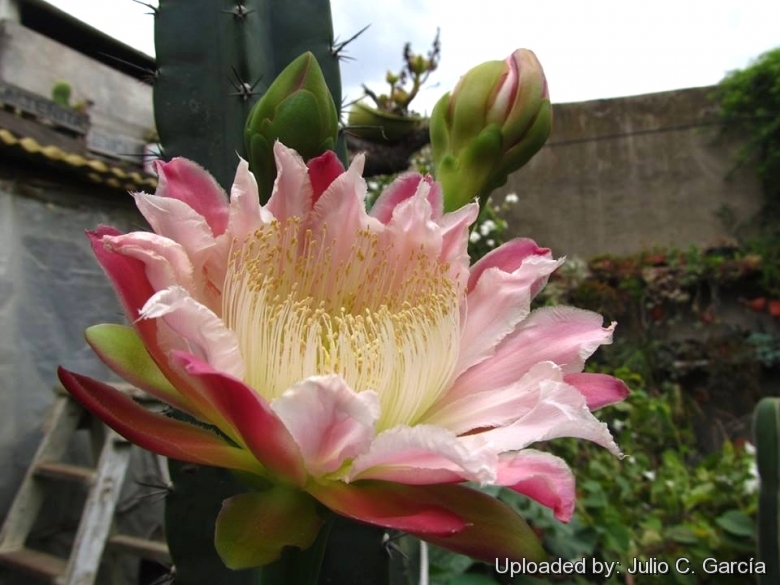
Cactus heptagonus (Cereus peruvianus) Photo by: Julio C. García
Origin and Habitat: South America, it is widespread cultivated for living fences and as an ornamental plant and thus difficult to know its natural occurrence; probably native to the western Caribbean and Venezuela (or Brazil). The species is common in gardens in tropical and subtropical countries around the world and has been planted commercially as a fruit crop on a small scale in Netherlands Antilles, other Caribbean, Mexico, Israel and USA and often subspontaneous from abandoned cultivations. In South Africa it is considered a weed.
Ecology: In spite of its nocturnal flower opening, day time active honey bees can act as pollinators using the few hours the flowers are open in the late evening or early morning.
Synonyms:
See all synonyms of Cereus repandus
back
Accepted name in llifle Database:Cereus repandus (L.) Mill.Gard. Dict., ed. 8. n. 5. 1768 [16 Apr 1768]Synonymy: 35
back
Common Names include:
ENGLISH: Peruvian tree, Blue Cereus, Peruvian apple cactus, Peruvian apple, Hedge cactus, Giant club cactus, Apple cactus
CHINESE (中文): 六角柱 (Taiwan), 山影掌
FRENCH (Français): Cierge du Pérou
HEBREW (עברית): קובו
ITALIAN (Italiano): Cereus peruviano
LITHUANIAN (Lietuvių): Venesuelinis stulpenis
RUSSIAN (Русский): Цереус перуанский
SPANISH (Español): Cardón uruguayo, Cacto candelabro, Kadushi, Cadushi
TURKISH (Türkçe): Dev Lobut Kaktüsü, Çit Kaktüsü
Description: The Peruvian apple cactus (Cereus repandusSN|6464]]) more often known under the name of Cereus peruvianus, it is a tall, spreading columnar cactus well known to cactus fanciers throughout the world. It is grown mostly as an ornamental plant, but it has some local culinary importance, and is probably the most widely cultivated Cereus.
Habit: It is a perennial treelike stem succulent, often with many upright or slightly curved branches above, often with distinct trunks up to 10 m high (but usually less)
Stems: Cylindrical, somewhat slender, segmented, grey-green to blue, 10-20 cm in diameter.
Ribs: 9-10, fairly low, rounded, somewhat compressed and undated, to 1 cm high.
Areoles: Small, widely separated.
Spines: Extremely variable, often numerous, sometimes absent, grey, needle-like, the longest to 5 cm.
Flowers: Nocturnal, each flower opens for just one night and then shrivels up, white with reddish tips, 12-15 cm long. It is self-incompatible and requires cross-pollination to obtain fruits.
Blooming season: During the warm season Cereus peruvianus produces several flower flushes.
Fruits: The fruits, known locally as "Pitaya", “Peruvian Apple” or “ Koubo” are globose to elongate up to 4 cm long, thornless usually red with white pulp, but skin colour vary from yellow to deep violet-red. The edible flesh is white and contains small, edible, crunchy seeds. Fruits tend to crack during ripening and flesh sweetens as the fruit opens out fully. The optimum harvest stage is when the fruits are close to or at full ripeness. Once harvested, the ripe fruits must be eaten within twenty-four hours, or they begin to ferment. Fruit take about 40-50 days to swell and ripen, so there are often flowers and fruits on the plant at the same time. A single large plant may produces hundred of fruits every year.
Remarks: The cells of Cereus Peruvianus contain an immense quantity of crystals of oxalate of lime (a.k.a. raphides) that in some parts of the tissue may form at least an 80% of the whole mass. They appear to the naked eye like very fine glittering sand, and, under the microscope, as rectangular prisms, with tetraedral points and a square or parallelogrammic base. They may be found abundantly in most succulent Monocotyledons, but in no plants had they been seen so abundant or so large as in Cereus repandusSN|6464]].
Subspecies, varieties, forms and cultivars of plants belonging to the Cereus repandus group
Notes: Even more intriguing, the apple cactus is widely touted as having the power to correct physical ailments caused by electromagnetic radiation. How and why this particular virtue was discovered are unclear, but the plant is widely sold potted with the recommendation that it he located near a computer screen or television in order to reestablish an electromagnetic equilibrium upset by the device. Or some such thing.
Bibliography: Major references and further lectures:
1) Edward Anderson “The Cactus family” Timber Press, Incorporated, 2001
2) James Cullen, Sabina G. Knees, H. Suzanne Cubey "The European Garden Flora Flowering Plants: A Manual for the Identification of Plants Cultivated in Europe, Both Out-of-Doors and Under Glass" Cambridge University Press, 11/Aug/2011
3) David R Hunt; Nigel P Taylor; Graham Charles; International Cactaceae Systematics Group. "The New Cactus Lexicon" dh books, 2006
4) Thomas Mawe, John Abercrombie “The Universal Gardener and Botanist: or, a general Dictionary of Gardening and Botany” 1778
5) Urs Eggli, Leonard E. Newton: “Etymological Dictionary of Succulent Plant Names” Springer, Berlin/Heidelberg 2010
6) N. L. Britton, J. N. Rose: “The Cactaceae. Descriptions and Illustrations of Plants of the Cactus Family.” Volume II, The Carnegie Institution of Washington, Washington 1920
7) Park S. Nobel “Cacti: Biology and Uses” University of California Press, 2002
8) Jules Janick, Robert E. Paull “The Encyclopedia of Fruits and Nuts” CABI, 2008
9) Peter Hanelt, Richard Büttner “Mansfeld's Encyclopedia of Agricultural and Horticultural Crops: (Except Ornamentals)” Springer, 01/Jan/2001
10) J. Weiss, A. Nerd, and Y. Mizrahi. “Development of Cereus peruvianus (Apple Cactus) as a new crop for the Negev desert of Israel” p. 486-471. In: J. Janick and J.E. Simon (eds.), New crops. Wiley, New York.1993.
11) David Yetman “The Great Cacti: Ethnobotany & Biogeography” University of Arizona Press, 2007
12) “The Journal of the Royal Institution of Great Britain”, Volume 1 - Royal Institution of Great Britain 1831
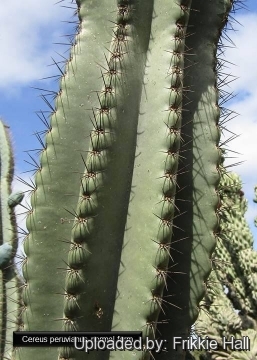 Cactus heptagonus (Cereus peruvianus) Photo by: Frikkie Hall
Cactus heptagonus (Cereus peruvianus) Photo by: Frikkie Hall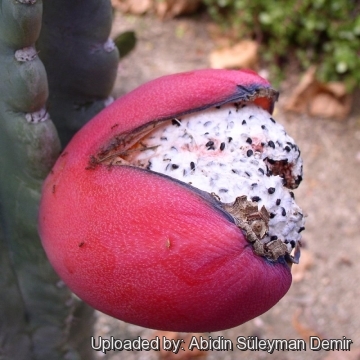 Cactus heptagonus (Cereus peruvianus) Photo by: Abidin Süleyman Demir
Cactus heptagonus (Cereus peruvianus) Photo by: Abidin Süleyman Demir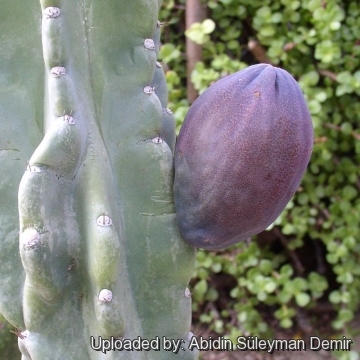 Cactus heptagonus (Cereus peruvianus) Photo by: Abidin Süleyman Demir
Cactus heptagonus (Cereus peruvianus) Photo by: Abidin Süleyman Demir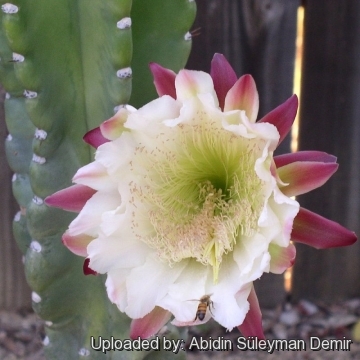 Cactus heptagonus (Cereus peruvianus) Photo by: Abidin Süleyman Demir
Cactus heptagonus (Cereus peruvianus) Photo by: Abidin Süleyman DemirCultivation and Propagation: Cereus peeruvianus is very easy to cultivate, easy to propagate, tolerates moderate frost, and produces numerous showy white flowers 15 cm across.
Growth rate: It grows quickly (a young plant will easily grow more than a 30 cm per year) and a plant grown in loose fertile soil with ample water availability may get up to 9 metres tall with dozens of branches in only 10 years.
Soils: For pot culture it needs standard cactus soil. Outdoors needs well drained spots, with deep soil, but will still thrive in less than ideal conditions. The species is sensitive to salinity.
Repotting: Since they are big-sized plants, they need plenty of space for their roots. Repotting should be done every other year, or when the plant has outgrown its pot. Use pot with good drainage.
Watering: Water regularly in summer, but do not overwater and allow to dry fully before watering again. Its roots are easily lost in pots that stay damp for any length of time. It should not be watered at all in winter. In the rest period no high atmospheric humidity!! Care must be taken with watering as they tends to become swollen and untidy in growth habit if given too much water and shade.
Fertilization: During the growing season enrich the soil using a fertilizer rich in potassium and phosphorous, but poor in nitrogen, because this chemical element doesn’t help the development of succulent plants, making them too soft and full of water.
Hardiness: Reputedly sensitive to frost , but less so if kept on the dry side prior to, and during, cold weather (hardy to -5° C for short periods). However some warmth throughout the year will increase the grower's success (minimum 5° to 8°C during rest season). In presence of high atmospheric humidity make sure that your saguaros are not exposed to freezing temperatures, or they may die. Outdoors this plant is very adaptable, as long as you avoid excessive humidity in the winter months.
Exposition: Light shade when young, full sun later. Outside it likes strong sunshine, but is tolerant and do well with light shade during the hot Summer months, inside it needs bright light, and some direct sun.
Garden uses: Excellent as landscape or patio plant. It is suitable for “desert” gardens, in association with other xerophytes. Where the open air cultivation is not possible due to the climate, it is to be cultivated in pot in order to shelter it in winter. It look fine in a cold greenhouse and frame. Slow growing and delicate cactus species can be grafted on Cereus peruvianus root stocks to provide faster growth.
Uther uses: Fruits and stems of Cereus repandus are edible, the cactus is cultivated for use as a living fence, its wood has been used in making furniture and for firewood, and sliced stems have been used as a soap substitute. The goose-egg-size fruits contain a delicately sweet white pulp with delightfully crunchy black seeds. They possess the added virtue that their husks are free of spines. The plant's rapid growth and fruit production apparently have made it attractive throughout the tropics.
Pests & diseases: It may be attractive to a variety of insects, but plants in good condition should be nearly pest-free, particularly if they are grown in a mineral potting-mix, with good exposure and ventilation. Nonetheless, there are several pests to watch for:
- Red spiders: Sensitive to red spider mite. Overhead watering is helpful in controlling mites.
- Mealy bugs: Occasionally mealy bugs they develop aerial into the new growth among the wool with disfiguring results, but the worst types develop underground on the roots and are invisible except by their effects.
- Scales: Scales are rarely a problem.
- Rot: Rot it is only a minor problem with cacti if the plants are watered and “aired” correctly. If they are not, fungicides won't help all that much.
Propagation: From cuttings in spring (let them dry till the ends callous well). Then replant them in fresh cactus soil that is ever so slightly moist, and keep them that way till they root), or by Seeds (Seeds should be sown in a well-drained soil mix. Surface sowing is the best; seeds germinate in 14-28 days at 25° C . The seedlings should not be disturbed until they are well rooted, after which they can be planted separately in small pots.















